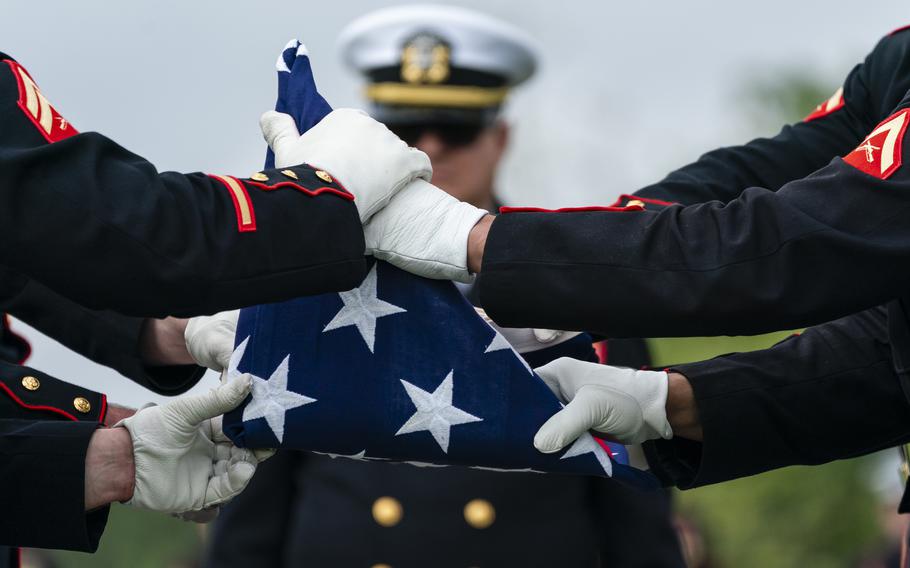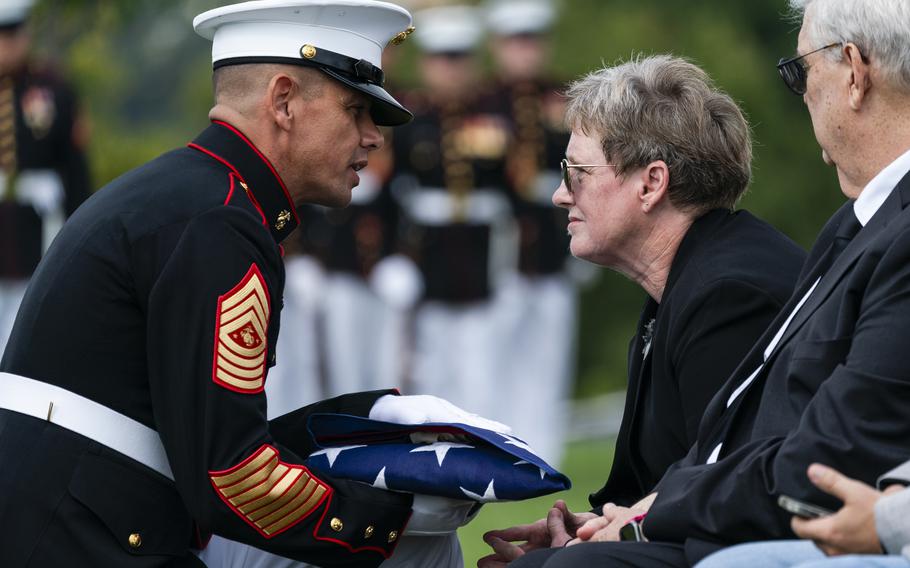
Marines fold a flag during a service for Pfc. Lawrence Earl Garrison at Arlington National Cemetery on Thursday. Garrison was killed during the Battle of Tarawa in the Pacific on Nov. 20, 1943. DNA sequencing led to the identification of his remains nearly 80 years later. (Eric Lee/The Washington Post)
On Lawrence Earl Garrison’s first day of battle in November 1943, he joined nearly 35,000 Marines on the atoll of Tarawa in an attempt to seize the Japanese-held Gilbert Islands in the central Pacific.
Two years earlier, the United States had been drawn into World War II after Japan bombed Pearl Harbor. Now the U.S. military was closing in on Japan in the Battle of Tarawa, a conflict from Nov. 20 to 23, 1943, in what is now the Republic of Kiribati. About 1,000 U.S. troops died during the battle, and more than 2,000 were wounded.
On the first day of the battle, Garrison — part of the 2nd Battalion, 8th Marine Regiment, 2nd Marine Division — suffered fatal gunshot wounds. Pfc. Garrison was 23.
Without dog tags or rings, Garrison’s remains were unidentifiable, said Jordan Windish, an osteoarchaeologist at History Flight, a nonprofit that helps identify missing-in-action troops, who has worked on identifying remains from Tarawa.
For close to 80 years, his family searched for closure. That process came to an end Thursday, when Garrison’s remains were buried in a somber ceremony at Arlington National Cemetery.
Over those decades, his family members — many of whom hadn’t ever met Garrison, said Dwayne Taylor, 76, Garrison’s nephew — had done what they could to learn about how Garrison might be identified. There wasn’t much to be done, said Cheryl Cronin, 66, Garrison’s niece. After all, “forensic science was at its infancy” for much of that time, Cronin said.
So they had to make do with the memories and stories they had of his upbringing in Ryan, Okla. “My father always said how sometimes Lawrence would go hunting to help feed the family” during the Great Depression, Cronin said. “I know he was a man of real faith.”
Many sets of unidentified remains from the Battle of Tarawa, including Garrison’s, were transported to Hawaii in 1946, Windish said. More than 72,000 Americans are still missing from World War II, according to data from the Defense POW/MIA Accounting Agency (DPAA), a federal agency that tracks down missing defense personnel.
Then, in 2009, the DPAA, History Flight and the Armed Forces Medical Examiner System, a scientific lab that identifies missing-in-action service members, partnered to exhume and identify Tarawa troops.
After Cronin read about this effort, she contacted the DPAA and learned that some people killed in Tarawa had been identified through DNA sequencing, she said. So around 2013, she contacted family members to send DNA samples to the DPAA.
For older cases like Garrison’s, one of the techniques used by the DPAA and History Flight is mitochondrial DNA sequencing.
Sequencing uses an individual’s DNA sample to generate a corresponding genetic code, which can then be overlaid with another individual’s sequence to see whether they are related. “Mitochondrial DNA-based sequencing technologies are becoming much more common,” said Thomas Clements, a biology lecturer at Vanderbilt University. Since mitochondrial DNA is generally more abundant than other types of genetic material, this type of sequencing is “useful in identifying certain samples that have degraded with age or when the sample size is low,” he said.
DNA sequencing, though, is usually the last resort when identifying remains, given its expense, Windish said. First, they’ll review dental records and look for material evidence such as dog tags and rings. “But really, DNA is going to be the one that costs the most money because it’s a scientific technique.”
Mitochondrial DNA sequencing has its limitations. This kind of DNA is inherited exclusively from the mother, so the family would have to collect DNA samples from Garrison’s maternal lineage.
Cronin couldn’t provide the sample; she is Garrison’s brother’s daughter. So another niece — who is now deceased — contributed the sample, Cronin said.
Mitochondrial DNA sequencing lays the groundwork for genetic identification, said Timothy McMahon, director of Defense Department DNA operations at the Armed Forces Medical Examiner System. To zero in on a potential match, the system used Y chromosome testing — from another relative’s sample — to track Garrison’s father’s lineage, McMahon said.
In August 2022, the DPAA and History Flight notified the family that Garrison’s remains had been identified, Windish said. At first, Cronin thought the call was a scam. Then realization set in. The mystery was finally solved.
“I am just so overwhelmed with gratitude,” Cronin said. Throughout the long hunt for Garrison’s remains, she had thought of “what this would have meant to him. [We’re] just so grateful for all the advances in science and the fact that we have the government and people that are dedicated to recovering people like this.”

Marine Corps Sgt. Maj. Carlos A. Ruiz presents a folded flag to Cheryl Cronin, niece of Pfc. Lawrence Earl Garrison, during a service at Arlington National Cemetery on Thursday. (Eric Lee/The Washington Post)
Since 2009, History Flight has identified more than 150 military members, a majority of whom died in Tarawa, Windish said.
Rapid scientific advancement has made it possible for the DPAA, in partnership with groups like the Armed Forces Medical Examiner System and History Flight, to identify hundreds of people annually in recent years, vs. “a couple of dozen a year” previously, Windish said. Since the 1970s — when the DPAA renewed its recovery efforts — nearly 1,000 troops killed in World War II have been identified and had their remains returned to their families.
That’s partly because technological advancement has generally made genome sequencing less costly, Clements said. The process has become more automated, and scientists can “process large amounts of sequence data simultaneously using computational-based technology,” he said. As such, it’s more feasible to identify people through DNA sequencing, Windish said. At the beginning of the 21st century, whole-genome sequencing cost $100 million per person; now it costs less than $1,000.
For Garrison’s family, these advancements culminated in a long-awaited funeral Thursday. Marines fired three ceremonial rounds of seven gunshots — traditionally a war signal to cease fire and allow troops to pick up corpses on the battlefield. Gunpowder filled the air as the chaplain recited a sermon before officially laying to rest an 80-year mystery.